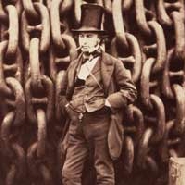The extraordinary ways in which Brunel and his contemporaries transformed the methods and experiences of sea travel and how their influence can still be felt today will be explored at the University of Bristol on Thursday 20 April.
Speakers from the world of cultural and historical enquiry will come together with engineers and designers to consider the importance of sea travel in shaping the modern world.
Professor Tim Unwin of the University of Bristol will speak on Brunel’s ss Great Eastern, the largest ocean-going liner of its day, conceived in 1851 (six years after the ss Great Britain was launched) and constructed in the mid-1850s. The ss Great Eastern was a truly magical vessel, designed to steam around the world without refuelling. It captured the imagination of the French writer Jules Verne whose voyage on the ship from Liverpool to New York in March-April 1867 inspired a story entitled The Floating City.
Professor Unwin, author of Jules Verne: Journeys in Writing, will argue that, for Verne, the vessel was the quintessence of nineteenth-century technological achievement, a remarkable feat of engineering that combined newfound mobility with hitherto unimagined space and comfort.
“While Verne is often thought of as a futuristic, science-fiction author who explored fantastic technologies in his writing, the truth is that he was much more interested in the actual technological changes occurring in his own century,” Professor Unwin said.
Professor Thom Gorst of the University of the West of England will give a talk on modern maritime ruins. Around the coast of Britain, there are a number of vessels of substantial size lying in a state of dereliction, stranded in time between active trade and possible preservation or, more likely, eventual scrapping.
These include the Manxman, a classic Isle of Man ferry that now lies in Sunderland having never sailed under her own steam since 1982, the Royal Iris, a famous Mersey ferry boat of 1951 that now lies derelict at Woolwich on the Thames and the Duke of Lancaster, a Heysham ferry of 1956 that has stood idle on the North Wales coast for 25 years: so long that Professor Gorst believes it should be listed as a protected monument.
Professor Gorst will evaluate the sorts of arguments put forward by informal groups for the ships’ preservation and compare these ships with derelict buildings, both in terms of their cultural significance and legal status.
Three other talks will look at the interior layout and design of British ocean liners and how it reflected and reinforced social hierarchies to be found on land, the development of the modern cruise ship, and the challenges that the growth in ship sizes presented to port engineers, faced with Britain’s lack of good natural harbours.
The event has been funded by Brunel 200 and organised by Dr Claire O’Mahony, Director of History of Art Lifelong Learning. It will also include a visit to the ss Great Britain and a private view of the Brunel and the Art of Invention exhibition at the Bristol City Art Gallery and Museum with Dr O’Mahony, the exhibition’s curator.
The symposium will be held in the University’s Department of History of Art, 42 Woodland Road from 9.30 a.m. to 4 p.m., followed by a visit to the ss Great Britain and private view at the Bristol City Art Gallery and Museum.
The other speakers are Professor Anne Massey of Kingston University (Accommodating the Passenger: The Interior Design of British Ocean Liners), Dr Bruce Peter, Glasgow School of Art (Sailing Sunward: Tage Wandborg and the development of the modern cruise ship) and Dr Adrian Jarvis, University of Liverpool (The Problems Marine Engineers and Naval Architects and their Employers made for Port Engineers).
